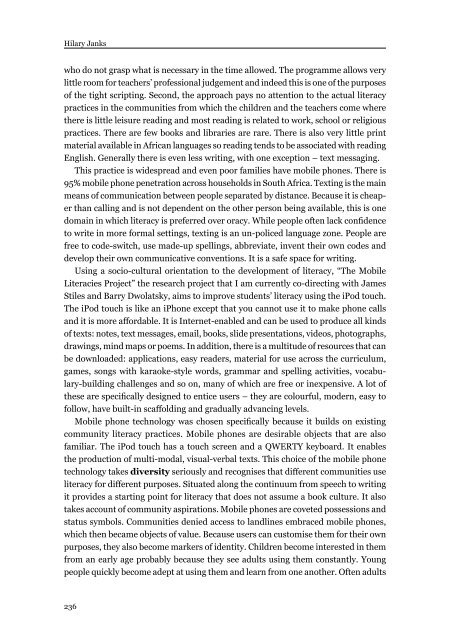Download issue - Umeå universitet
Download issue - Umeå universitet
Download issue - Umeå universitet
Create successful ePaper yourself
Turn your PDF publications into a flip-book with our unique Google optimized e-Paper software.
Hilary Janks<br />
who do not grasp what is necessary in the time allowed. The programme allows very<br />
little room for teachers’ professional judgement and indeed this is one of the purposes<br />
of the tight scripting. Second, the approach pays no attention to the actual literacy<br />
practices in the communities from which the children and the teachers come where<br />
there is little leisure reading and most reading is related to work, school or religious<br />
practices. There are few books and libraries are rare. There is also very little print<br />
material available in African languages so reading tends to be associated with reading<br />
English. Generally there is even less writing, with one exception – text messaging.<br />
This practice is widespread and even poor families have mobile phones. There is<br />
95% mobile phone penetration across households in South Africa. Texting is the main<br />
means of communication between people separated by distance. Because it is cheaper<br />
than calling and is not dependent on the other person being available, this is one<br />
domain in which literacy is preferred over oracy. While people often lack confidence<br />
to write in more formal settings, texting is an un-policed language zone. People are<br />
free to code-switch, use made-up spellings, abbreviate, invent their own codes and<br />
develop their own communicative conventions. It is a safe space for writing.<br />
Using a socio-cultural orientation to the development of literacy, “The Mobile<br />
Literacies Project” the research project that I am currently co-directing with James<br />
Stiles and Barry Dwolatsky, aims to improve students’ literacy using the iPod touch.<br />
The iPod touch is like an iPhone except that you cannot use it to make phone calls<br />
and it is more affordable. It is Internet-enabled and can be used to produce all kinds<br />
of texts: notes, text messages, email, books, slide presentations, videos, photographs,<br />
drawings, mind maps or poems. In addition, there is a multitude of resources that can<br />
be downloaded: applications, easy readers, material for use across the curriculum,<br />
games, songs with karaoke-style words, grammar and spelling activities, vocabulary-building<br />
challenges and so on, many of which are free or inexpensive. A lot of<br />
these are specifically designed to entice users – they are colourful, modern, easy to<br />
follow, have built-in scaffolding and gradually advancing levels.<br />
Mobile phone technology was chosen specifically because it builds on existing<br />
community literacy practices. Mobile phones are desirable objects that are also<br />
familiar. The iPod touch has a touch screen and a QWERTY keyboard. It enables<br />
the production of multi-modal, visual-verbal texts. This choice of the mobile phone<br />
technology takes diversity seriously and recognises that different communities use<br />
literacy for different purposes. Situated along the continuum from speech to writing<br />
it provides a starting point for literacy that does not assume a book culture. It also<br />
takes account of community aspirations. Mobile phones are coveted possessions and<br />
status symbols. Communities denied access to landlines embraced mobile phones,<br />
which then became objects of value. Because users can customise them for their own<br />
purposes, they also become markers of identity. Children become interested in them<br />
from an early age probably because they see adults using them constantly. Young<br />
people quickly become adept at using them and learn from one another. Often adults<br />
236

















